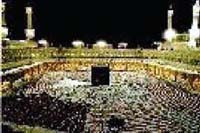 Living in compact community in Xi’an, there are about 50,000 Moslems who believe in Islam and have the largest population among the minorities in Xi’an. Two mosques have been built at this region where Huis reside, which are called the East Great Mosque and the West Great Mosque because of their locations--- one in the east & the other in the west. Yet the East Great Mosque is on a comparatively large scale. The East Great Mosque introduced here is located at Huajue Lane, the northwestern side of the Drum Tower in the center of Xi’an. Living in compact community in Xi’an, there are about 50,000 Moslems who believe in Islam and have the largest population among the minorities in Xi’an. Two mosques have been built at this region where Huis reside, which are called the East Great Mosque and the West Great Mosque because of their locations--- one in the east & the other in the west. Yet the East Great Mosque is on a comparatively large scale. The East Great Mosque introduced here is located at Huajue Lane, the northwestern side of the Drum Tower in the center of Xi’an.
It is recorded on the tablets inside the Mosque at Huajue Lane that the Mosque here was first built in 742 AD (the 1st year in the regin of Emperor Tian Bao in the Tang Dynasty) and was repaired in 1384 AD (the 17th year of the regin of emperor Hong Wu in the Ming Dynasty). The architecture of the mosque is in the Ming style. The East Great Mosque can be divided into 4 big courtyards, covering an area of more than 12,000 square meters, and forming a series of complete historic buildings. The main building in the front yard is an eight-meter high wooden memorial gateway with glazed, upturned eaves. The stone tablet in the second courtyard recorded the repair work in the Ming and Qing dynasties. There is a "month tablet" carved in Arabic in the western side of the courtyard. which is the important reference of the calcuation of the Hui calendar. A three-storeyed octagonal topmost roof toward the central inspire terrace and tower called "Retrospection Tower" is seen standing in the center when you enter the third courtyard, which is the place from where order are sent to call the Moslems to come to worship. The three-gates (called Lian San Men) paralleled with the "Retrospection Tower" in the west is the fourth courtyard, with the main buildings of the Mosque clustering here. there is a pavilion named "Yi Zhen" (the Pavilion of Phoenix as well) standing inside the center of this courtyard, with the six-gabled, upturned eaves adjoined by three pavilions, and it is very beautiful in architecture. Two words "Yi Zhen" written by Tie Xuan in 1399 AD (the first year of Emperor Hui in the Ming Dynasty) are hung on the "Yi Zhen Pavilion" (or the Pavilion of Phoenix). "The Stele on the Repairing of the Mosque" is stored and kept inside this courtyard, which is of the first year of Emperor Tiao Bao. Across the fish pond---Chinese flowering crabapple pond, walking up the stairs, passing the stone gate, coming to the platform, a large-scaled main hall is seen, which is seven-room wide and nine-room long, covering an area of about 1,3000 square meters, and can house more than a thousand worshipers each time. The hall consists of as the front corridor, the Prayer Hall and the rear courtroom. The horizontal inscribed board absolving other has been hung in the hall, which was bestowed by Zhu Li, Emperor Cheng Zu in the Ming Dynasty in 1405 to imam at that time, Sayidiha Morutin of Arab. The celling, the walls of the hall are decorated with patterens of painted trailingplants, which can be regarded as the art treasures of Islam in China.
Thanks to the rigorous arrangement of the Mosque, and the special style & features of each courtyard as well as its art treasures, the Mosque was highly praised by Han Suyin, a British Chinese author, and regarded as "An excellent and outstanding ancient mosque" after her visit to the mosque. Nowadays, the Mosque at Huajue Lane is not only the place where the Huis worship, but also the opening and visiting place to hostile Muslim and Arabic State leaders.
|